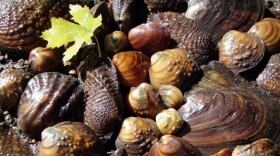This summer, plant and algal blooms in northern Wisconsin lakes have been a hot topic of discussion. At UW Trout Lake Station, we have received reports of surface-covering purple bladderwort, heard stories of bright green threads rising from rocky lake bottoms in new locations, and have had concerned lake residents stop in with jars full of soupy blue-green waters. Discussions with our natural resource partners indicate that plant and algal concerns are prominent this summer.
Seasonal blooms are common and often monitored in warm and high nutrient lakes throughout southern Wisconsin, but are less commonly reported in lakes up north. This makes it challenging to track and manage across the 1,000s of regional lakes. Here, I hope to shed some light on what’s creating the bountiful blooms in our water bodies.
The evolutionary history of algae and aquatic plants includes repeated loss and gain of cell structures, and a process called endosymbiosis. Originally, photosynthesis took place within ocean-dwelling bacterial cells that evolved the ability to capture sunlight’s energy in pigments and chemical pathways. As long as 2.4 billion years ago photosynthetic bacteria played a huge role in oxygenating the earth’s atmosphere and creating the trajectory for our current oxygen and green plant dependent existence.
Different bacteria evolved pigments that capture red, green, and blue wavelengths of light at varying degrees of success, leaving us with many colorful photosynthetic lineages that exist across the tree of bacterial life today. Cyanobacteria, one of the most common and concerning groups in Wisconsin waters, consists of bacterial species that look ‘cyan’ or blue-green giving them the common name blue-green algae.
In contrast to these bacterial groups, green algae are eukaryotes meaning they contain a nucleus and organelles essential for their survival. Green algae evolved long after photosynthesizing bacteria and their origin involved a process called endosymbiosis where two cells live so closely together that their replication and survival become completely dependent on each other. The ancestor of green algae was a large cell that engulfed a living photosynthetic bacterium. The large cell provided protection and nutrients to the bacterial cell while the bacterium captured the sun’s energy and leaked that energy, sharing with its larger host cell. Over time, both organisms became completely dependent on this relationship, together winning the selective race for dominance across waterways. Eventually, their DNA and life processes became completely intertwined, giving rise to the chloroplasts or plastids within green algae and land plants. Green algae are often vibrant green and can grow as single cells, in clusters, as filaments, or can even look like little plants. While plants are close relatives to green algae, plants have evolved complex respiratory and transport systems that differentiate them from green algae.
Brown and red algae, present in freshwater but more common in marine systems, have equally interesting origins and even more complex tales of endosymbiosis. Red algae are like German nesting dolls where inside a large cell are evidence of a smaller algal cell whose chloroplast is remnant of an engulfed photosynthetic bacteria.
Algae – so much past and complexity in these tiny unicellular creatures. ‘Algae’ are mobile and non-mobile, single-celled and multicellular, grow solo, in clusters, and as long filaments, and are mostly eukaryotic even though we still often use the term blue-green algae and harmful algal blooms (or HABS) to talk about cyanobacterial species.
All this algal knowledge can be applied to identifying what is in a bloom! First, take a stick and try to scoop some up. If it looks like it has leaves, a stem or you can readily observe different structures, it is likely a plant. If it is stringy and looks like hair or cotton candy hanging off the stick, it is most likely a green alga that grows in filaments. While plant and green algae blooms can be a nuisance and indicate something is amiss within a system, they are not toxic. They can be reoccurring or a one-time event and some blooms are completely natural and can benefit ecosystems. Year to year and seasonal observations are key for deciding when and how to address green algae and plant blooms. These records are also great to help document environmental changes over time.
If the sample slides off the stick in an oily mess or it looks like your stick was dipped in a can a of paint, it is likely cyanobacteria. For another quick and easy test for cyanobacteria, dip a glass jar below the water surface and collect a sample. Place the clean, capped, half full jar in a dark fridge overnight. Cyanobacteria will accumulate at the top of the jar while green algae will mostly sink. This is because cyanobacteria have special structures that change gas concentrations allowing them to float up and down in the water column.
If all signs point to a cyanobacterial bloom, share what you have found with portals at the EPA and your local Natural Resources but don’t panic! There are many non-toxic cyanobacteria that can bloom. Further microscopic evaluation and testing is accessible through the Wisconsin State Lab of Hygiene. While waiting for the bloom to fade or results from the lab, take the opportunity to step back and let the water recover. Or better yet, enjoy engaging with another of the many lakes within the region.









